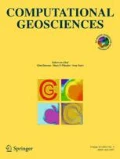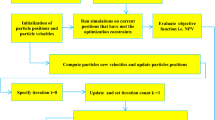Abstract
Determining the optimum type and location of new wells is an essential component in the efficient development of oil and gas fields. The optimization problem is, however, demanding due to the potentially high dimension of the search space and the computational requirements associated with function evaluations, which, in this case, entail full reservoir simulations. In this paper, the particle swarm optimization (PSO) algorithm is applied for the determination of optimal well type and location. The PSO algorithm is a stochastic procedure that uses a population of solutions, called particles, which move in the search space. Particle positions are updated iteratively according to particle fitness (objective function value) and position relative to other particles. The general PSO procedure is first discussed, and then the particular variant implemented for well optimization is described. Four example cases are considered. These involve vertical, deviated, and dual-lateral wells and optimization over single and multiple reservoir realizations. For each case, both the PSO algorithm and the widely used genetic algorithm (GA) are applied to maximize net present value. Multiple runs of both algorithms are performed and the results are averaged in order to achieve meaningful comparisons. It is shown that, on average, PSO outperforms GA in all cases considered, though the relative advantages of PSO vary from case to case. Taken in total, these findings are very promising and demonstrate the applicability of PSO for this challenging problem.
Similar content being viewed by others
References
Alander, J.T.: On optimal population size of genetic algorithms. In: Proceedings of CompEuro ’92 Computer Systems and Software Engineering, pp. 65–70 (1992)
Artus, V., Durlofsky, L.J., Onwunalu, J., Aziz, K.: Optimization of nonconventional wells under uncertainty using statistical proxies. Comput. Geosci. 10(4), 389–404 (2006)
Bangerth, W., Klie, H., Wheeler, M.F., Stoffa, P.L., Sen, M.K.: On optimization algorithms for the reservoir oil well placement problem. Comput. Geosci. 10, 303–319 (2006)
Bittencourt, A.C., Horne, R.N.: Reservoir development and design optimization. Paper SPE 38895 presented at the 1997 SPE Annual Technical Conference and Exhibition, San Antonio, 5–8 October 1997
Braendler, D., Hendtlass, T.: The suitability of particle swarm optimisation for training neural hardware. In: International Conference on Industrial and Engineering Applications of Artificial Intelligence and Expert Systems, IEA/AIE, pp. 190–199. Springer, New York (2002)
Brandstatter, B., Baumgartner, U.: Particle swarm optimization–mass-spring system analogon. IEEE Trans. Magn. 38, 97–1000 (2002)
Cao, H.: Development of techniques for general purpose research simulator. Ph.D. Thesis, Stanford University (2002)
Carlisle, A., Dozier, G.: An off-the-shelf PSO. In: Proceedings of Workshop on Particle Swarm Optimization, pp. 1–6, Indianapolis, 6–7 April 2001
Chakrabarti, R., Chattopadhyay, P.K., Basu, M., Panigrahi, C.K.: Particle swarm optimization technique for dynamic economic dispatch. J. Inst. Eng. India 87, 48–54 (2006)
Clerc, M.: Back to random topology. Technical report, March 2007. http://www.clerc.maurice.fr/pso/ (2007)
Clerc, M.: Stagnation analysis in particle swarm optimisation or what happens when nothing happens. hal-00122031, version 1–23 Dec 2006. http://hal.archives-ouvertes.fr/hal-00122031/ (2006)
Clerc, M.: Particle Swarm Optimization. iSTE, London (2006)
Clerc, M.: Standard PSO 2007. http://www.particleswarm.info (2007)
Deb, K.: Multi-objective optimization using evolutionary algorithms, 1st edn. Wiley, West Sussex (2001)
Eberhardt, R.C., Kennedy, J.: A new optimizer using particle swarm theory. In: Proceedings of the 6th International Symposium on Micromachine and Human Science, pp. 39–43 (1995)
Schlumberger Eclipse: 2004. Schedule User Guide 2004A, Chapter 6: Technical description
Engelbrecht, A.P.: Fundamentals of Computational Swarm Intelligence. Wiley, West Sussex (2005)
Farshi, M.M.: Improving genetic algorithms for optimum well placement. Master’s Thesis, Stanford University (2008)
Franstrom, K.L., Litvak, M.L.: Automatic simulation algorithm for appraisal of future infill development potential of Prudhoe Bay. Paper SPE 59374 presented at the 2000 SPE/DOE Improved Oil Recovery Symposium, Tulsa, 3–5 April 2000
Goldberg, D.E.: Genetic Algorithms in Search, Optimization, and Machine Learning. Addison-Wesley, Reading (2004)
Gong, T., Tuson, A.L.: Particle swarm optimization for quadratic assignment problems—a forma analysis approach. Int. J. Comput. Intell. Res. 4, 177–185 (2008)
Guyaguler, B., Horne, R.N.: Uncertainty assessment of well placement optimization. SPE Reservoir Evaluation & Engineering, pp. 24–32 (2004)
Haupt, R.L., Haupt, S.E.: Practical Genetic Algorithms, 2nd edn. Wiley, New York (2004)
Helwig, S., Wanka, R.: Theoretical analysis of initial particle swarm behavior. In: Proceedings of the 10th International Conference on Parallel Problem Solving from Nature (PPSN08), pp. 889–898. Springer, Dortmund (2008)
Jiang, Y.: Techniques for modelling complex reservoirs and advanced wells. Ph.D. Thesis, Stanford University (2007)
Kennedy, J., Mendes, R.: Neighborhood topologies in fully-informed and best-of-neighborhood particle swarms. In: Proceedings of the IEEE International Workshop on Soft Computing in Industrial Applications, pp. 45–50. IEEE, New York (2003)
Kennedy, J., Eberhardt, R.C.: Particle swarm optimization. In: Proceedings of the IEEE International Joint Conference on Neural Networks, pp. 1942–1947. IEEE, Piscataway (1995)
Litvak, M., Gane, B., Williams, G., Mansfield, M., Angert, P., Macdonald, C., McMurray, L., Skinner, R., Walker, G.J.: Field development optimization technology. Paper SPE 106426 presented at the 2007 SPE Reservoir Simulation Symposium, Houston, 26–28 February 2007
Mattot, L.S., Rabideau, A.J., Craig J.R.: Pump-and-treat optimization using analytic element method flow models. Adv. Water Resour. 29, 760–775 (2006)
Miranda, V., Keko, H., Duque, A.J.: Stochastic star communication topology in evolutionary particle swarms (epso). Int. J. Comput. Intell. Res. 4(2), 105–116 (2008)
Onwunalu, J.: Optimization of nonconventional well placement using genetic algorithms and statistical proxy. Master’s Thesis, Stanford University (2006)
Sarma, P., Chen, W.H.: Efficient well placement optimization with gradient-based algorithms and adjoint models. Paper SPE 112257 presented at the 2008 SPE Intelligent Energy Conference and Exhibition, Amsterdam, 25–27 February 2008
Shi, Y., Eberhardt, R.C.: A modified particle swarm optimizer. In: Proceedings of the 1998 IEEE International Conference on Evolutionary Computation, pp. 69–73. IEEE, New York (1998)
Spall, J.C.: An overview of the simultaneous perturbation method for efficient optimization. John Hopkins APL Tech. Dig. 19(4), 482–492 (1998)
Tupac, Y.J., Faletti, L., Pacheco, M.A.C., Vellasco, M.M.B.R.: Evolutionary optimization of oil field development. Paper SPE 107552 presented at the 2007 SPE Digital Energy Conference and Exhibition, Houston, 11–12 April 2007
Wang, C., Li, G., Reynolds, A.C.: Optimal well placement for production optimization. Paper SPE 111154 presented at the 2007 SPE Eastern Regional Meeting, Lexington, 11–14 October 2007
Williams, G.J.J., Mansfield, M., Macdonald, D.G., Bush, M.D.: Top-down reservoir modeling. Paper SPE 89974 presented at the 2004 SPE Annual Technical Conference and Exhibition, Houston, 26–29 September 2004
Yeten, B.: Optimum deployment of nonconventional wells. Ph.D. thesis, Stanford University (2003)
Yeten, B., Durlofsky, L.J., Aziz, K.: Optimization of nonconventional well type, location and trajectory. SPE J. 8, 200–210 (2003)
Zandvliet, M.J., Handels, M., van Essen, G.M., Brouwer, D.R., Jansen, J.D.: Adjoint-based well-placement optimization under production constraints. SPE J. 13(4), 392–399 (2008)
Zhang, W.J., Xie, X.F., Bi, D.C.: Handling boundary constraints for numerical optimization by particle swarm flying in periodic search space. In: IEEE Congress on Evolutionary Computation, vol. 2, pp. 2307–2311. IEEE, Piscataway (2004)
Author information
Authors and Affiliations
Corresponding author
Rights and permissions
About this article
Cite this article
Onwunalu, J.E., Durlofsky, L.J. Application of a particle swarm optimization algorithm for determining optimum well location and type. Comput Geosci 14, 183–198 (2010). https://doi.org/10.1007/s10596-009-9142-1
Received:
Accepted:
Published:
Issue Date:
DOI: https://doi.org/10.1007/s10596-009-9142-1




